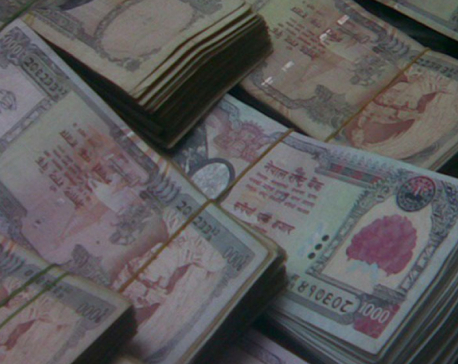
OR
Banks still walk the tightrope on deposits, loans
Published On: April 8, 2017 10:39 AM NPT By: Republica | @RepublicaNepal
KATHMANDU, April 7: Banks have extended more loans than the total deposits they have mobilized in the first four months of 2017, indicating that they are still walking a tightrope between deposits and loans.
While 28 commercial banks have collected Rs 81 billion in new deposits in the last four months ending on March 31, they extended Rs 99 billion in loans in that period, according to deposit and lending figures compiled by Nepal Bankers Association. The data shows that these banks have a mobilized a Rs 1,947 billion in deposits and Rs 1,634 billion in loans by March 31.
According to a banker, the loan disbursement has outpaced deposit collection as Nepal Rastra Bank (NRB) has provided a policy relaxation to the BFIs to extend loans equivalent to half the amount that they lent on productive sector even without mobilizing new deposits. “There has not been much growth in deposits despite banks raising interest rates on fixed deposits to as high as 13 percent,” the banker said. “Still, flow of loans is growing. This is partly because some deposit is coming into the system, and also due to flexibility on calculating CCD ratio provided by the regulator,” he added, referring to the policy relaxation on the calculation of credit to core capital-cum-deposit (CCD).
After the credit crunch problem hit lending capacity of banks, the central bank had offered a relaxation to the BFIs through mid-term review of the monetary policy which allowed them to float loans without adding deposits. The central bank allowed the bank to subtract 50 percent of productive sector loans from the CCD ratio until mid-July this year.
This regulatory relaxation implies that banks can extend loans equivalent to 50 percent of the credit expanded in the productive sector even without mobilizing fresh deposits.
Banks have been facing shortage of lendable fund for the past few months after their credit expansion outpaced deposit growth rate. As bank’s credit flow started rising amid aggressive lending, credit to core capital-cum-deposit (CCD) ratio of many commercial started to cross the regulatory limit of 80 percent, making it difficult for them to expand loans. Lending came to a halt in many banks that breached the CCD ratio, prompting rise in interest rates on both loans and deposits. While one-year fixed deposit rate went up to as high as 13 percent, BFIs were also quick to increase their lending rate. However, attractive interest rate on fixed deposits has failed to lure depositors.
While banks worry that the deposit base will deplete further next week as taxpayers will be withdrawing around Rs 30-40 billion, they are hopeful of getting rid of the ‘credit crunch’ gradually when development spending starts gaining pace toward the fiscal year end. Rise in capital expenditure means more money is pumped into the banking system.
You May Like This

Banks still walk a tightrope on deposits, loans
KATHMANDU, April 6: Banks have extended more loans than the total deposits they have mobilized in the first four months of... Read More...

Commercial banks issued loans 16 times more than deposits collection in five months of current FY
KATHMANDU, Dec 17: Commercial banks issued additional loans worth Rs 360 billion in the first five months of the current fiscal... Read More...

Commercial banks collected deposits of Rs 11 billion last week, eased the liquidity problem a bit
KATHMANDU, Dec 7: Nepali banks have started receiving some respite in their liquidity position with an increased deposit collection recently. ... Read More...







Just In
- NRB to provide collateral-free loans to foreign employment seekers
- NEB to publish Grade 12 results next week
- Body handover begins; Relatives remain dissatisfied with insurance, compensation amount
- NC defers its plan to join Koshi govt
- NRB to review microfinance loan interest rate
- 134 dead in floods and landslides since onset of monsoon this year
- Mahakali Irrigation Project sees only 22 percent physical progress in 18 years
- Singapore now holds world's most powerful passport; Nepal stays at 98th











Leave A Comment